Us kids who’d started school in the 1960s had been raised on Monopoly, Cluedo, Old Maid and Happy Families – classics all, to be sure – but the 1970s saw an explosion of innovative new board games and toys the arrival of which in our Christmas stockings would be an eagerly anticipated event. Here are just a few of them:
Games
1. Mastermind
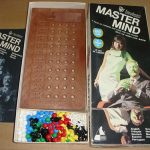
This wonderful game for two players was the brainchild of Israeli telecommunications expert Mordecai Meirowitz. Launched in 1970, it involved one player assuming the role of codemaker and the other of codebreaker. The codemaker would place four coloured pegs behind a shield and the codebreaker, who could not see behind the shield, would need to work out what the colours were and in which sequence they were placed. Each attempt would be “marked” by the codemaker, giving the codebreaker a clue as to how warm he or she was. Points were awarded on the basis of how many attempts it took to crack the code, and the player with the most points after an agreed number of rounds would be the winner. More elaborate spin-offs included Royale Mastermind and Grand Mastermind.
2. Haunted House
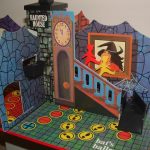
Also created in 1970, this children’s board game by the Milton Bradley Company featured four large rooms – the Bat’s Ballroom, Witchin’ Kitchen, Spell Cell and the Broom Room. The game was three-dimensional, with each room being protected by a vertical wall, and in the centre of the board was a chimney. A token was moved around the board as cards were drawn from a stack. A Ghoulish Gertie card required a “whammy ball” to be dropped down the chimney which returned the token to the starting position. Drawing Wanda the Wicked would change the human-shaped token into a mouse of the same colour, which could then make no further progress until a Glenda the Good card allowed the player to be transformed back into a human child. The end of the track was called the Charmed Circle, and the first player to reach it was the winner.
3. Top Trumps

Still a big favourite in the games industry, Top Trumps first appeared to us in 1978 and was hugely popular with schoolchildren who would play it in groups during their breaks. Each card would contain a list of numerical data, and upon drawing their next card the player calling the shots would nominate which field he or she thought would trump the cards of their rivals. This process would continue until the caller was beaten, whereupon the lead would be passed to the player who had trumped them. A successful round meant collecting the cards of defeated rivals, and the game ended when one player was left holding all the cards and was thus declared the winner. Games were based on various themes including cars, aircraft, battleships, tanks, sports, animals – indeed just about every conceivable subject has been adopted over the decades that followed the launch of this hugely successful and enduring game.
4. Headache
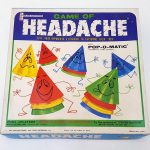
Actually designed in 1968, Headache nonetheless became popular during the onset of the 1970s. Published by Milton Bradley, it involved players moving cone-shaped pieces around a board in increments determined by the number shown on two dice contained in a “pop-o-matic” bubble located in the centre of the board. One of these die would feature a numerical value, whilst the other allowed for a second run if it showed a red spot facing upwards. When a player’s cone landed upon a space already occupied by the cone of a rival, the rival’s cone was captured and the player’s cone would be stacked on top of it. “Stacks” had the advantage of being able to move either forwards or backwards in their quest to make more captures. The game was won when one player had control over all the cones belonging to the other players.
5. Connect Four
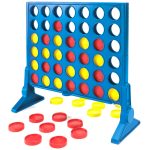
Also published by Milton Bradley, Connect Four was launched in 1974 and was strictly for two players who would be issued coin-shaped discs in either red or yellow. Discs would be dropped in turn into a vertical grid, where they occupied the lowest available space in the chosen column. The game was won when the first player managed to form a row of four discs of his or her colour, whether vertical, horizontal or diagonal. Connect Four is still played widely today.
.
Toys
1. Space Hopper

The iconic large orange rubber ball with a face and two “ears” which doubled as handles for the user, the space hopper came to symbolise children’s play in the 1970s. Kids of a certain age could be found everywhere, seated joyously upon this large inflatable contraption and bounding hither and thither. Many became expert at “steering” the hopper by leaning in a particular direction when bouncing.
2. Stylophone
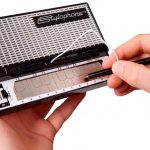
Whether this was actually a toy or a serious musical instrument depended largely upon proficiency of use. David Bowie famously used it on his debut hit single Space Oddity, but for most its potential seldom breached the dizzy heights of Ba-Ba Black Sheep and London Bridge is Falling Down. For those interested in the technical details, Wikipedia describes it as “a metal keyboard made of PCB and played by touching it with a stylus – each note being connected to a voltage-controlled oscillator via a different-value resistor – thus closing a circuit”.
3. Spirograph
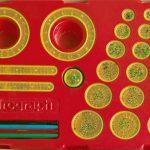
Developed in 1965 by British engineer Denys Fisher, ownership was subsequently acquired by Hasbro Inc. and the Spirograph reached the peak of its popularity during the decade which followed. A clever geometric drawing device, Spirograph employed a set of mathematical roulette curves to produce some breathtaking spiral drawings.
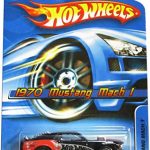
4. Hot Wheels
Whilst Matchbox was the undisputed king of the scale-model car industry, Hot Wheels rose to fame at the turn of the seventies to give the British manufacturer a run for its money. Generally Hot Wheels specialised in hot-rod type, souped-up fantasy cars as opposed to the more classical designs of its competitor. Designer Mattel also produced a stand-alone race track which was perfectly suited to the specific design of the Hot Wheels range of cars.
5. Rubik’s Cube
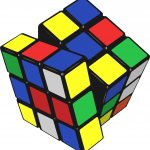
Okay, strictly speaking it became known as the Rubik’s Cube in 1980. But as the Hungarian Magic Cube designed by the inventor Ernő Rubik in 1974, this classic multi-coloured puzzle block became a firm favourite with children of all ages – including the grown-up ones. Each “face” comprised nine cubic blocks, each side painted in a different colour. The object of the exercise was to rotate and manipulate the blocks until each of the six faces of the cube comprised one colour only. The Rubik’s Cube continues to be the toy of choice for puzzle enthusiasts everywhere, and in more recent years international competitions have been held and world records set and recorded. Meanwhile many of us from the 1970s are still trying to crack it for the first time.

If you enjoyed reading this article, make sure you stay updated with all Phil’s latest blog posts by signing up to receive his free Newsletter. You can unsubscribe at any time and your details will never be shared with any third party. Click here to sign up today.
I was never big on board (bored games as I’d say.) Still not. Bit Connect 4 and mastermind I loved. And I recall my Dad buying one of those state of the art musical instruments! He was quite musical, and could pick out a tune … but who ever thought a Stylophone would help change the face of Music?